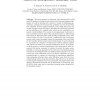Free Online Productivity Tools
i2Speak
i2Symbol
i2OCR
iTex2Img
iWeb2Print
iWeb2Shot
i2Type
iPdf2Split
iPdf2Merge
i2Bopomofo
i2Arabic
i2Style
i2Image
i2PDF
iLatex2Rtf
Sci2ools
ECCV
2006
Springer
2006
Springer
Segmentation and Guidance of Multiple Rigid Objects for Intra-operative Endoscopic Vision
Abstract. This paper presents an endoscopic vision framework for modelbased 3D guidance of surgical instruments used in robotized laparoscopic surgery. In order to develop such a system, a variety of challenging segmentation, tracking and reconstruction problems must be solved. With this minimally invasive surgical technique, every single instrument has to pass through an insertion point in the abdominal wall and is mounted on the end-effector of a surgical robot which can be controlled by automatic visual feedback. The motion of any laparoscopic instrument is then constrained and the goal of the automated task is to safety bring instruments at desired locations while avoiding undesirable contact with internal organs. For this "eye-to-hands" configuration with a stationary camera, most control strategies require the knowledge of the out-of-field of view insertion points location and we demonstrate it can be achieved in vivo thanks to a sequence of (instrument) motions without...
| Added | 22 Aug 2010 |
| Updated | 22 Aug 2010 |
| Type | Conference |
| Year | 2006 |
| Where | ECCV |
| Authors | Christophe Doignon, Florent Nageotte, Michel de Mathelin |
Comments (0)

